In the fishing world, there are those that like to target the big specimens, those that like to target variety and those that aren’t fussy! Whilst catching big fish is certainly rewarding and can provide a great adrenaline rush, fishing for a variety of species, so-called species fishing or species hunting, can be equally as fun and definitely as challenging! Species fishing is a great way to develop your kayak fishing skills, as in order to up your species count you have to get clever and work out the best ways to catch a wide variety of fish species, from the small right up to the big. With well over a hundred fish species possible to catch on rod and line in UK waters, the species hunter has plenty to go for. The major UK saltwater kayak fishing competitions are also based on catching the most species so it make sense to get to grips with the rigs that give with the best chance of catching a good variety.
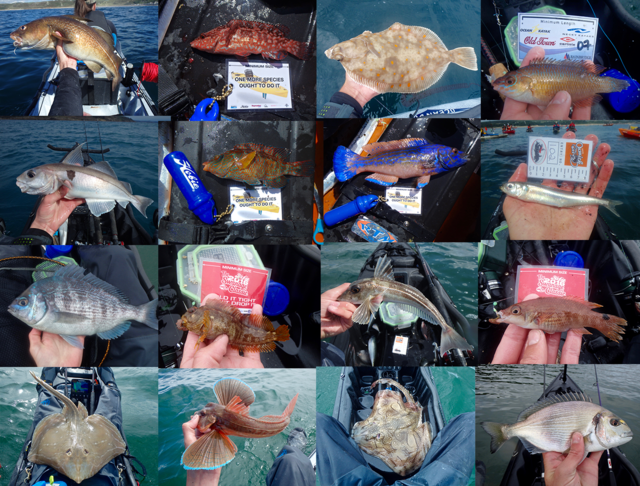
Whilst some species require a specialist approach, the vast majority can be caught using ‘ready-made’ rigs that can be found at any good tackle shop, or caught on simple and easy to make rigs. I use the rigs discussed below, or variations of these rigs, for the vast majority of my kayak fishing. These rigs can be fished in mid-water, on the sea-bed and over pretty much any type of ground. I have mentioned likely species that will be caught using these particular rigs but it will very much depend on your location as to what is likely to take the bait. Nevertheless, these rigs will give you a great chance of catching fish at just about any location. So, here are my top three rigs for saltwater species kayak fishing …
Baited Hokkais
Hokkai rigs are a type of attractor rig where the hooks are dressed to mimic small bait fish. This is often achieved using a small rubber fish head and various feathers, tinsels or foils. Typically these come as three or five hook pre-tied rigs with heavy mono rig bodies and can be found at most tackle shops.
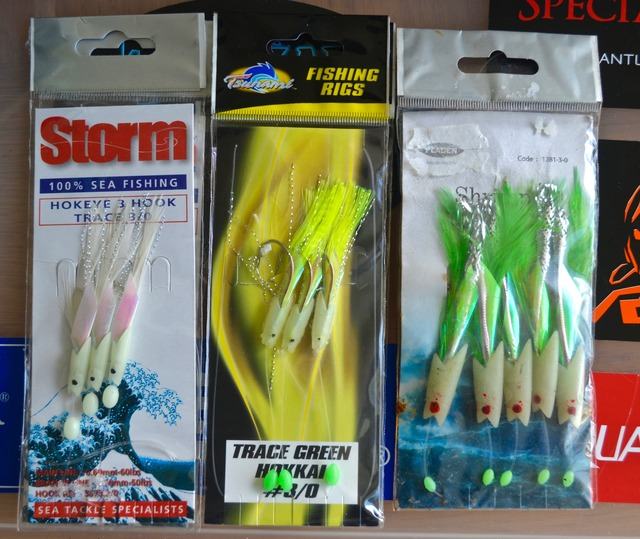
Hook sizes vary but for catching variety try to find some with hook sizes between a Size 2 and 3/0. They can come in various colours and I tend to favour the ones with luminous fish heads and white feathers. Hokkais are good for targeting the medium-sized species we find around our coastline.
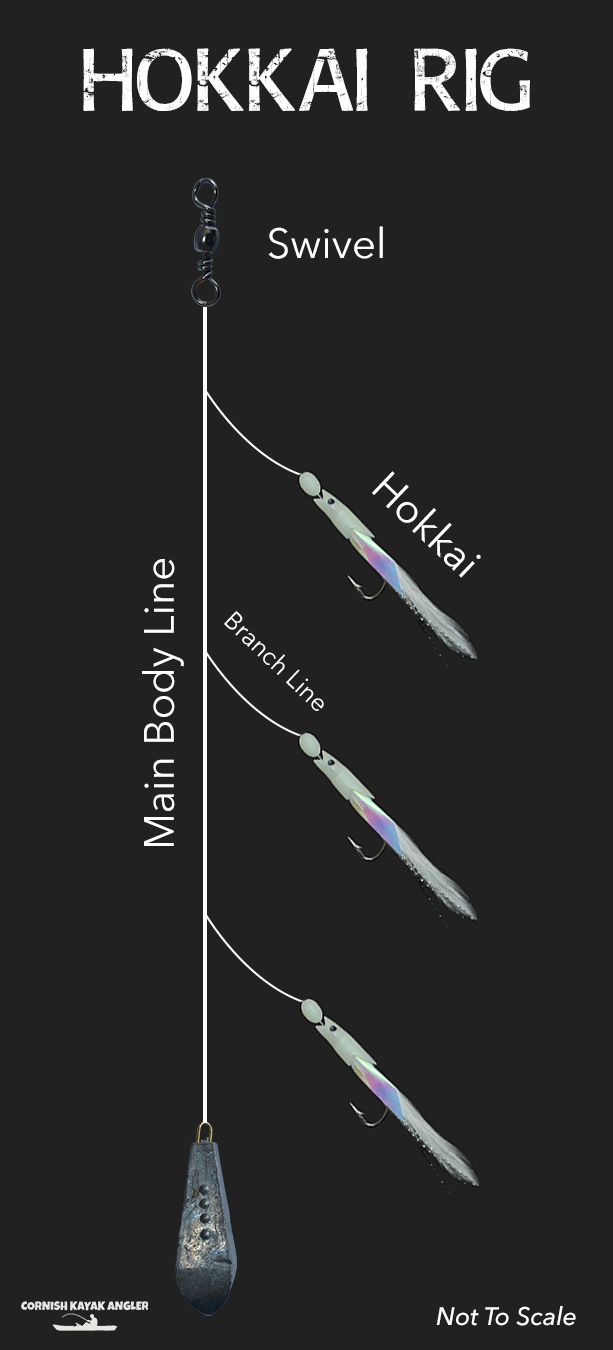
They can be fished straight out of the packet and when jigged in mid-water will pick up baitfish such as Mackerel, Scad and possibly Herring. If jigged over reefs and rough ground then they are effective for catching pollock, cod, coalfish and potentially bass.
I find Hokkais most effective at catching a variety of species when the hooks are baited. Tip the hooks with small 1-2” long x 0.5” wide strips of mackerel, and then bounce or drag along clean ground to give you a chance of Whiting, red gurnards, grey gurnards, tub gurnards, dogfish, weevers, pouting, and potentially flatfish such as plaice and dabs. Haddock are also a possibility in deep water in some areas of the UK. When fished over rougher ground and reefs the ever-obliging pollock will usually be caught as well as the possibility of cod, coalfish, cuckoo wrasse and, if in deeper water, ling. Tipping the hooks with worm baits, such as ragworm, or lugworm will bring some extra bites from a variety of colourful wrasse species including ballan wrasse and cuckoo wrasse.
Baited Hokkais are very effective and are great for exploring new venues and for racking up the species count. They quite often find some nice sized specimens too! This rig can be fished on heavier gear, I favour 6-12 lb class gear, and with heavier weights, making it possible to fish in deeper waters of 30 m+ or in faster tides.
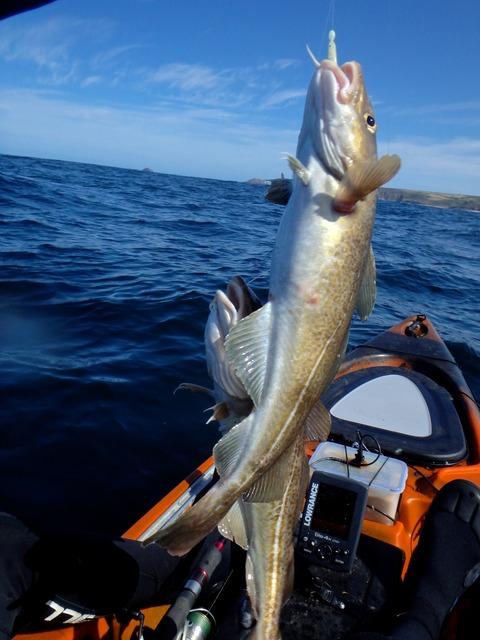
Baited Sabikis
Sabiki rigs are similar to Hokkai rigs but are built with lighter line, feature smaller hooks and the hooks are dressed with small pieces of dried fish skin, usually bound to the hook using luminous or brightly coloured material. The fish skin acts as the attractor, mimicking small pieces of food material or small fish fry. Often a sabiki rig will use small coloured beads on the line above the hook as additional attractors. These rigs are available at most tackle shops and tend to come with six to ten hooks on a single rig.
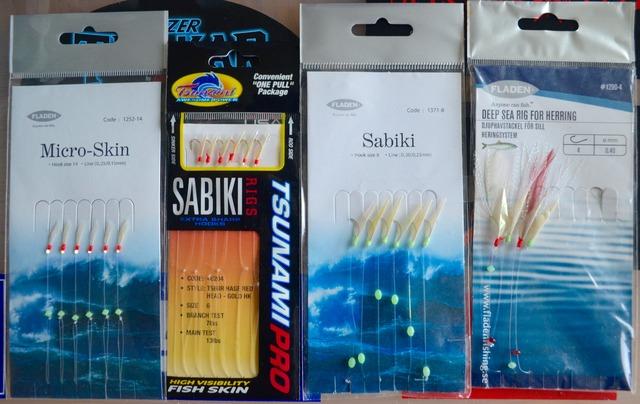
Using a Sabiki rig straight out of the packet with this many hooks is a recipe for lots of tangles on the confined space of a kayak! I like to cut the rig down into three hook sections – this is much easier to manage and you can get two or three rigs out of a pack – bargain! Hook sizes vary from about a Size 2 on large feathered sabikis, down to a tiny Size 14 or less on some micro-sabiki rigs!
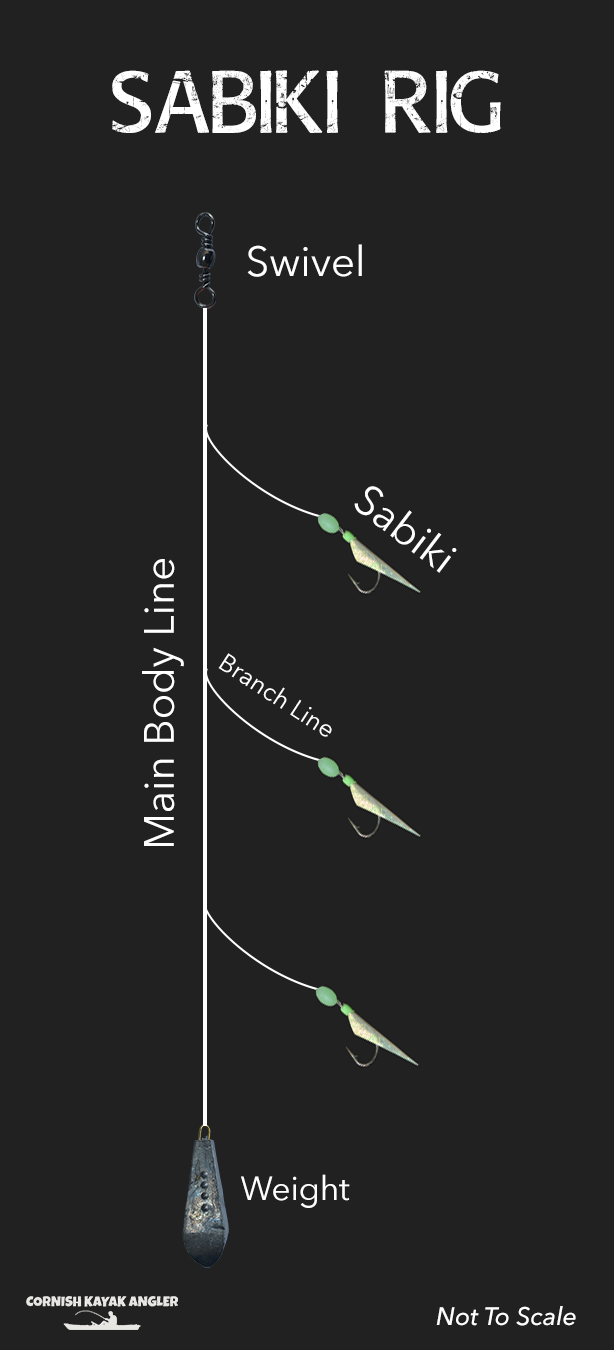
Sabiki rigs are phenomenal fish catchers! They target the smaller fish which are often more plentiful and are also great for catching mini-species not often caught on larger and heavier gear. They are a very good choice when competing in kayak species hunts, and you will see them used by practically everyone who places on the leader board.
They can be fished unbaited, and when jigged in mid-water and near the bottom will usually catch a variety of pelagic baitfish species including mackerel, herring, smelt, scad, pilchards, sprats, sandeels and more! You may also get small pollock, coalfish and others too.
They become very effective when fished baited. Simply tip the hooks with a small pinch of ragworm and you will catch a whole plethora of species, especially if you are anchored over rough ground. Small wrasse including ballan wrasse, corkwing wrasse and goldsinney wrasse are likely to be caught. Cuckoo wrasse, rock cook wrasse and, if you are very lucky, the rare Baillon’s wrasse are also possible in some areas too. Also likely to be caught are a whole host of mini-species including various gobies and blennies, as well as the mean-looking but harmless long-spined scorpion fish. Juvenile pollock, pouting, poor cod, whiting and others usually show up too. Drifted along the bottom on clean ground may find small flatfish such as dabs and plaice, along with weevers and possibly dragonets. Tip the hooks with small pieces of squid, or squid and ragworm and you may catch the hard-fighting black bream in some areas.
Sabikis really are an effective species catching rig and are great for exploring new venues to see what species are in the area. You can all-but guarantee bites! These rigs are most effective when fished on lighter gear (lure and LRF rods work well) with light 1 oz or 2 oz weights. This type of set up usually fishes best in shallower waters of less than 15 m. Take a few packs along on your next session or competition and you will soon be boosting your species count!
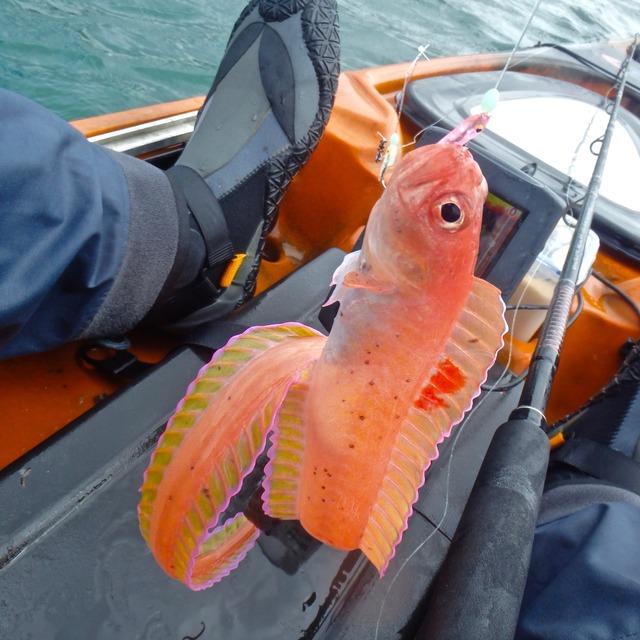
Single Hook Running Ledger
This is my favourite rig and is very versatile, being easily adapted for targeting small species right up to the very big species. A running ledger consists of a weight, which slides on mainline, followed by a separate trace line terminating in a hook. The trace is connected to the mainline via a swivel and the weight is usually buffered against the swivel knot using a bead or by attaching the weight to a zip slider. This rig is excellent for targeting fish that live on or just above the seabed and can be fished on the drift or static at anchor.
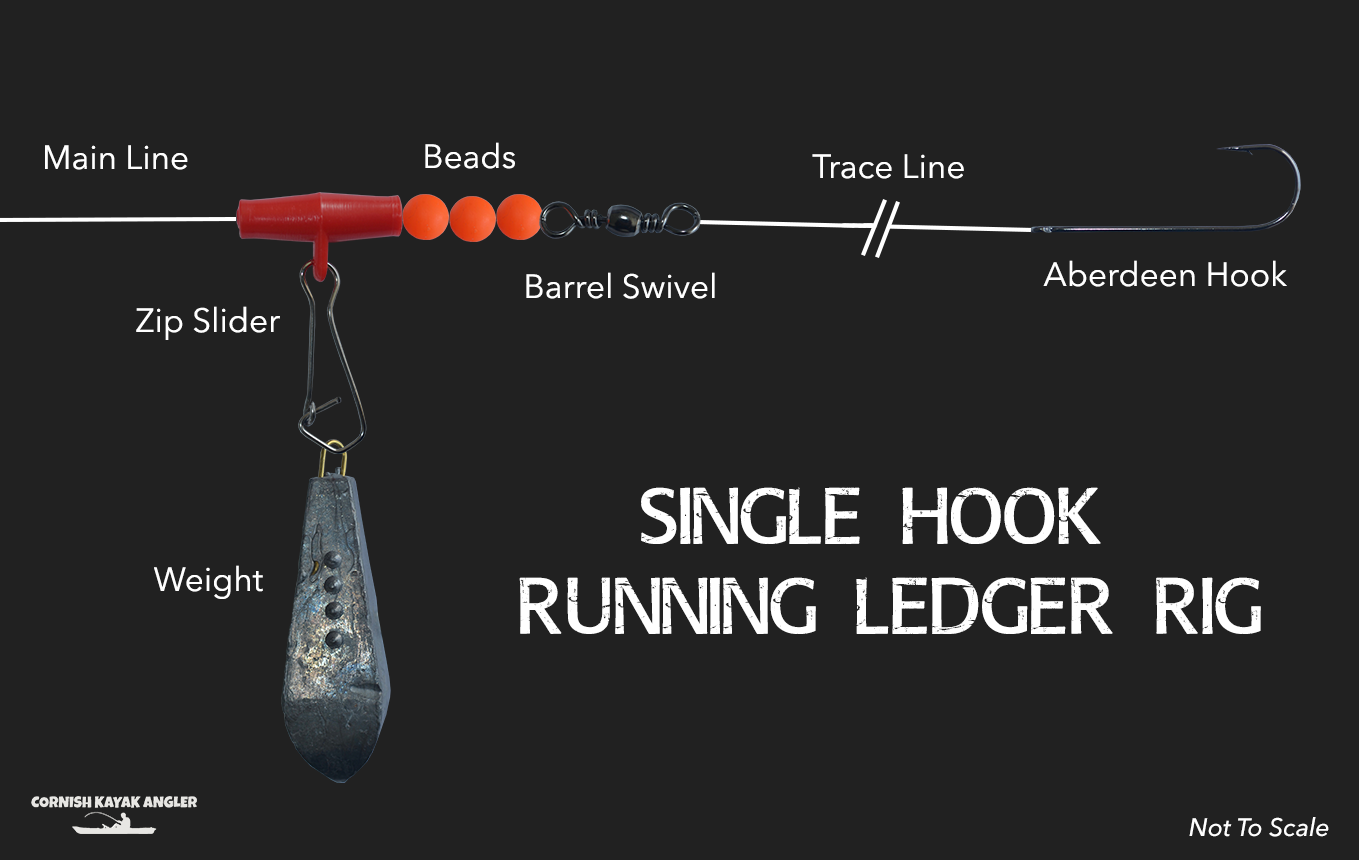
The versatility comes with the choice of mainline size, weight size, trace size and hook size. For targeting smaller fish use light lines – 10-15 lb or less main-line and trace is ample, lighter weights of 1 oz to 3 oz depending on conditions and small hooks less than a Size 2. When baited with worm baits this light running ledger is great for finding small wrasse, gobies, blennies and bream species when fished at anchor over rough or mixed ground. Drift the rig on clean ground and you’ll likely find small dabs, plaice and potentially other species such as red mullet. On muddier ground you may also find flounder. Bait up with strips of mackerel or a small section of sandeel and this rig will find smaller pollock, whiting, pouting and often small gurnards amongst other species. This light ledger rig works well on lighter spinning and lure rods.
I tend to fish this rig with a 30 lb braid mainline and 20-30 lb mono trace, weights between 3 oz and 6 oz depending on the conditions and a hook size between a Size 1 and 4/0. This is great for targeting the slightly bigger species. I especially like to fish this rig on the drift on clean ground. When baited with thin strips of mackerel it will often find good sized whiting, tub gurnards, red gurnards, grey gurnards, a variety of flatfish including plaice, turbot, brill and bigger dabs, with greater weevers and haddock also a possibility in some areas. Fish this rig at anchor on clean ground with fish bait and you’ll likely find rays species including thornback ray, small-eyed ray, spotted ray, blonde ray and undulate ray – although it will depend on your location as to which ray species are likely to be caught. The ever-obliging lesser spotted dogfish will usually put in appearance too, and if you’re on mixed ground you may be rewarded with the larger brother of the dogfish, a bull huss. If you bait up with worm or crab baits then this rig works well for cod and bass too, with the chance of smoothounds in some areas as well. This really is a fantastic rig! It works well on 6-12 lb or 12-20 lb class (or similar) boat rods – depending on the conditions you are fishing in.
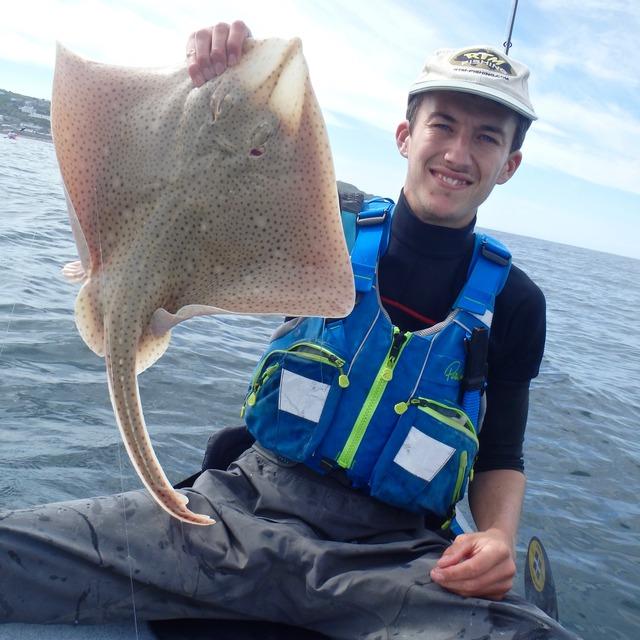
If you fancy your chances with some proper rod bending fish then a simple running ledger can be stepped up for strength. Use 25 lb+ mainline, heavier 4-8 oz weights depending on conditions, hook sizes up to a 10/0 depending on target species and trace lines between 30 lb and 200 lb+ depending on species! Stick on a BIG fish bait and wait for something toothy to come along. These rigs are often customised to fish well for a particular species but all work off the same simple running ledger principle. A heavy running ledger rig can be used to target conger eels, tope, big rays and even big skate! These rigs are best fished on heavier boat rods of 20 lb, 30 lb or 50 lb class depending on the species. It is worth researching the gear, rigs and specific sized components required for these species in more depth if you do wish to target them.
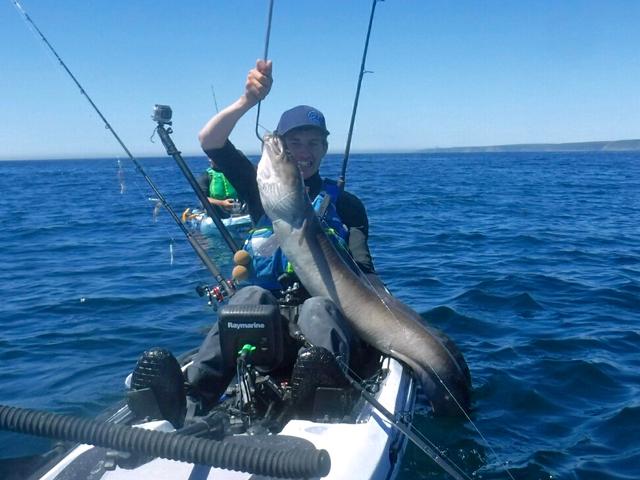
So there we are, my three favourite rigs for saltwater species fishing. On the right day fifteen or more species is certainly possible at some venues using a combination of these rigs. Give them a go and see how many species you can catch!